|
Home Theater Subwoofers
Size:
The size of a subwoofer (total cone area) is generally indicative of the amount of bass that a subwoofer will be able to produce. Actually the amount of bass that it will be able to produce is determined by the cone area and the distance that it moves from its point of rest (X-max). This means that a smaller diameter woofer MAY be able to produce more bass than a larger diameter woofer with a smaller x-max but generally, larger subwoofers (especially subs from the same company), will generally be able to produce more bass.
Passive Subwoofers:
Passive subwoofers are subs that are designed to be driven by an external amplifier. The amplifier may be a dedicated amplifier or from the speaker outputs of the home theater receiver. Some subs will have built in crossovers which will filter out the higher frequencies from the speaker level input signal. Others may require that the signal be filtered before it gets to the subwoofer. If the sub has a built in crossover that's designed to accept a full range speaker level input, it may have 'output' terminals/connections to send the remainder of the signal (input signal minus the bass) to a set of smaller satellite speakers.
This sub has no internal crossover. The high frequencies must be removed from the signal before it reaches the subwoofer.
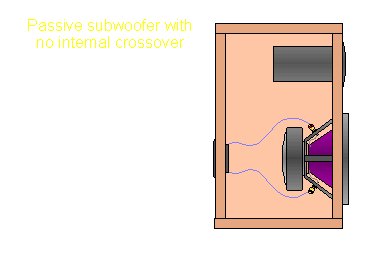
This subwoofer has a built in crossover and can accept a full range signal. The high frequencies will be removed from the audio signal by the subwoofer's internal crossover.
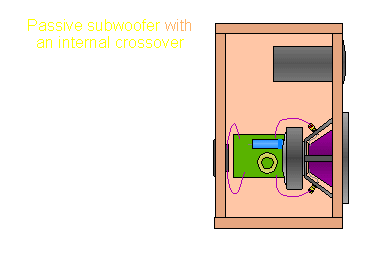
This subwoofer is designed to accept a full range signal. The internal crossover separates the bass from the higher frequencies and sends the bass to the woofer. The higher frequencies are sent to another set of terminals which would be connected to a small satellite speaker. Some woofers are designed to take the signal from both the left and right channels of the receiver and have outputs for left and right and even center speakers.
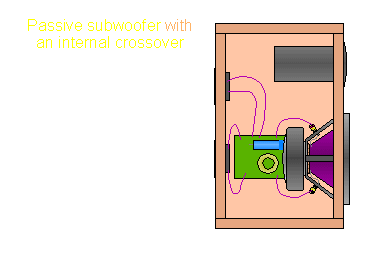
Active Subwoofers:
An active (or powered) subwoofer is generally much more flexible and more difficult to properly install. I will try to cover a few of the most common features. The simplest type of active subwoofer would contain an amplifier, a crossover and some type of input connections. Since it contains an internal power amplifier, it will also need mains power (it will have to be powered by a wall power outlet).
The diagram below shows a generic active subwoofer. You can see the amplifier's heat sink at the top of the subwoofer enclosure. The heat sink is designed to drain the heat away from the transistors. You can also see the back panel which has a few controls. The 'input level' control allows you to match the bass output level of the subwoofer to the rest of the system. The 'crossover frequency' control allows you to control the range of frequencies that the subwoofer will reproduce. The phase switch allows you to better integrate the subwoofer with the rest of the speakers in the system. It reverses the phase of the subwoofer's audio signal. To set it properly, you'll probably have to listen to it in both positions to see which position sounds best in your listening room.
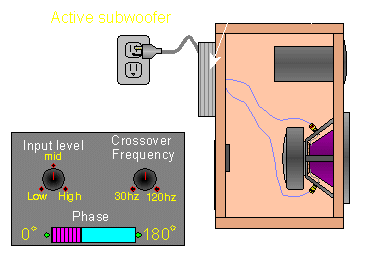
Other Active Subwoofer Features
Power Amplifier Output Power:
Generally, more output power will result in more output from a speaker (all else being equal). This is especially true if the subwoofers are from the same manufacturer. When looking at power ratings, make sure that you're comparing apples to apples. Some manufacturers use peak or max power to rate the power output of their subwoofer's amplifier output. Both peak and max ratings are generally useless. If a manufacturer states the output power as 'watts RMS continuous' the ratings are much more reliable/meaningful. The RMS rating is a true indicator of how much 'work' the amplifier can do (moving the speaker).
Auto on/off:
This feature allows the subwoofer to turn on when an input signal (audio from the receiver) is detected. There may be a sensitivity control on some subwoofers to allow the woofer to turn on with different levels of input signal. The sub will generally turn off after there is no input for a predetermined time period.
Servo Feedback:
There are a few subwoofers that use a feedback signal (from an accelerometer mounted on the speaker's cone). The feedback allows the output of the subwoofer to be monitored and lets the subwoofer's control circuitry adjust the output to reduce distortion levels. It is fairly common for a subwoofer's output to have as much as 10% harmonic distortion. The distortion levels tend to rise as the power input (volume) increases and at lower frequencies. The feedback circuits may be able to keep the distortion levels below 1%.
Down firing:
This type of woofer fires toward the floor instead of parallel to the floor and may be more efficient if the woofer is placed in the center of the room (not against the wall or in a corner). This type of sub will generally look more like a piece of furniture because there is generally no fabric covered grill.
Magnetically shielded:
Shielding reduces the effect that the subwoofer's magnet has on the picture of your television. This is especially important if the subwoofer will be placed near the TV. If unshielded speakers are placed near a TV, the colors will be skewed and may have some residual effect (the colors will stay distorted after the speaker/magnet is removed from the area). Most (all, as far as I know) direct view televisions have a degaussing coil wrapped around the picture tube and will degauss the the tube when the TV is powered up. Several cycles of powering up and powering down of the set will generally repair any residual damage done by a speaker's magnet.
Preamp Level Inputs:
This type of input is generally accomplished through RCA type cables/connectors. This is a low level signal that's not capable of driving a speaker directly. It is used to drive the input circuitry of a powered subwoofer. The input signal will come from the 'preamp out/main amplifier in' connection or from a dedicated preamp subwoofer output on the back of the receiver.
Preamp Level Outputs:
If your powered subwoofer has preamp level outputs, it is probably capable of accepting a full range signal and separating the high frequencies from the lower frequencies. The low frequencies are sent to the subwoofer's internal amplifier and the high frequencies are sent to a set of preamp (RCA) jacks that could be connected to an external amplifier to drive a set of satellite speakers.
Speaker Level Inputs:
This type of input (on an active/powered sub) will accept input from the speaker level outputs on the back of virtually any receiver.
Speaker Level Outputs:
This type of output is generally available on unpowered subwoofers where a passive crossover (built into the sub) separates the high frequencies from the low frequencies. The low frequencies are sent directly to the subwoofer and the high frequencies are sent to a set of speaker terminals on the sub's rear panel. The speaker outputs are generally designed to drive a set of satellite speakers.
Speaker Terminals:
There are various types of terminals used for speaker level connections on subwoofers.
Spring Terminals:
These terminals are some of the quickest type of terminals to use but they are probably also the most fragile. Most of the spring terminals use only the spring pressure to hold the wire in place.

Screw Down Connectors:
This type of terminal/connector will accept either bare wire or spade terminals. The spade terminal is simply inserted under the screw and the screw is then tightened down. You could also wrap the wire around the screw but with stranded wire it won't give you a very reliable connection.
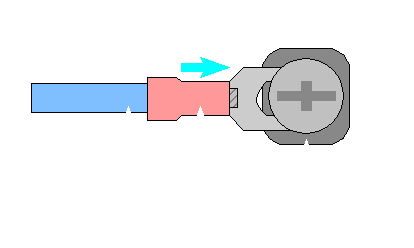
Binding posts:
This type of connector allows multiple types of connections. This first diagram shows how a stripped wire is simply inserted into the hole in the post and the nut is tightened down to hold the wire. You can also use spade lugs like in the previous diagram.
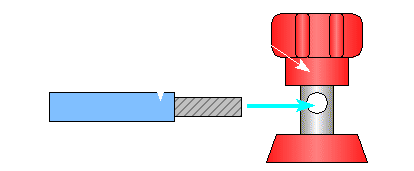
This diagram shows the binding post used with banana plugs. The banana plug is simply inserted into the top of the post. This type of connector is fast but easily disconnected if the wires are accidentally pulled. There are some banana plugs that have a screw through the center of the plug. When the screw is tightened, it causes the contacts to spread and hold firmly in the binding post.
|


